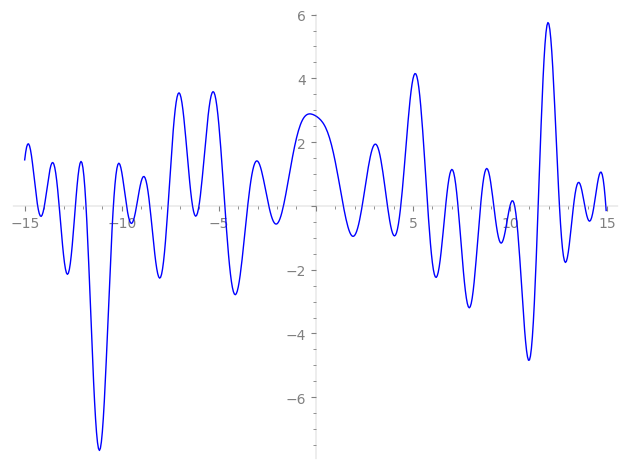| L(s) = 1 | + (1.72 − 0.143i)3-s + 2.77·5-s + (−0.855 + 2.50i)7-s + (2.95 − 0.496i)9-s + 3.43·11-s + (−0.429 − 0.743i)13-s + (4.78 − 0.398i)15-s + (−0.405 − 0.701i)17-s + (−0.750 + 1.29i)19-s + (−1.11 + 4.44i)21-s − 7.64·23-s + 2.68·25-s + (5.03 − 1.28i)27-s + (3.99 − 6.92i)29-s + (−3.60 + 6.24i)31-s + ⋯ |
| L(s) = 1 | + (0.996 − 0.0829i)3-s + 1.23·5-s + (−0.323 + 0.946i)7-s + (0.986 − 0.165i)9-s + 1.03·11-s + (−0.119 − 0.206i)13-s + (1.23 − 0.102i)15-s + (−0.0982 − 0.170i)17-s + (−0.172 + 0.298i)19-s + (−0.243 + 0.969i)21-s − 1.59·23-s + 0.536·25-s + (0.969 − 0.246i)27-s + (0.742 − 1.28i)29-s + (−0.647 + 1.12i)31-s + ⋯ |
\[\begin{aligned}\Lambda(s)=\mathstrut & 1008 ^{s/2} \, \Gamma_{\C}(s) \, L(s)\cr =\mathstrut & (0.969 - 0.246i)\, \overline{\Lambda}(2-s) \end{aligned}\]
\[\begin{aligned}\Lambda(s)=\mathstrut & 1008 ^{s/2} \, \Gamma_{\C}(s+1/2) \, L(s)\cr =\mathstrut & (0.969 - 0.246i)\, \overline{\Lambda}(1-s) \end{aligned}\]
Particular Values
| \(L(1)\) |
\(\approx\) |
\(2.819544756\) |
| \(L(\frac12)\) |
\(\approx\) |
\(2.819544756\) |
| \(L(\frac{3}{2})\) |
|
not available |
| \(L(1)\) |
|
not available |
\(L(s) = \displaystyle \prod_{p} F_p(p^{-s})^{-1} \)
| $p$ | $F_p(T)$ |
|---|
| bad | 2 | \( 1 \) |
| 3 | \( 1 + (-1.72 + 0.143i)T \) |
| 7 | \( 1 + (0.855 - 2.50i)T \) |
| good | 5 | \( 1 - 2.77T + 5T^{2} \) |
| 11 | \( 1 - 3.43T + 11T^{2} \) |
| 13 | \( 1 + (0.429 + 0.743i)T + (-6.5 + 11.2i)T^{2} \) |
| 17 | \( 1 + (0.405 + 0.701i)T + (-8.5 + 14.7i)T^{2} \) |
| 19 | \( 1 + (0.750 - 1.29i)T + (-9.5 - 16.4i)T^{2} \) |
| 23 | \( 1 + 7.64T + 23T^{2} \) |
| 29 | \( 1 + (-3.99 + 6.92i)T + (-14.5 - 25.1i)T^{2} \) |
| 31 | \( 1 + (3.60 - 6.24i)T + (-15.5 - 26.8i)T^{2} \) |
| 37 | \( 1 + (-0.458 + 0.793i)T + (-18.5 - 32.0i)T^{2} \) |
| 41 | \( 1 + (-1.67 - 2.90i)T + (-20.5 + 35.5i)T^{2} \) |
| 43 | \( 1 + (1.20 - 2.08i)T + (-21.5 - 37.2i)T^{2} \) |
| 47 | \( 1 + (0.307 + 0.532i)T + (-23.5 + 40.7i)T^{2} \) |
| 53 | \( 1 + (-6.31 - 10.9i)T + (-26.5 + 45.8i)T^{2} \) |
| 59 | \( 1 + (-0.734 + 1.27i)T + (-29.5 - 51.0i)T^{2} \) |
| 61 | \( 1 + (5.71 + 9.90i)T + (-30.5 + 52.8i)T^{2} \) |
| 67 | \( 1 + (-8.10 + 14.0i)T + (-33.5 - 58.0i)T^{2} \) |
| 71 | \( 1 + 14.4T + 71T^{2} \) |
| 73 | \( 1 + (4.16 + 7.22i)T + (-36.5 + 63.2i)T^{2} \) |
| 79 | \( 1 + (1.37 + 2.38i)T + (-39.5 + 68.4i)T^{2} \) |
| 83 | \( 1 + (-5.75 + 9.97i)T + (-41.5 - 71.8i)T^{2} \) |
| 89 | \( 1 + (5.11 - 8.85i)T + (-44.5 - 77.0i)T^{2} \) |
| 97 | \( 1 + (-3.82 + 6.63i)T + (-48.5 - 84.0i)T^{2} \) |
| show more | |
| show less | |
\(L(s) = \displaystyle\prod_p \ \prod_{j=1}^{2} (1 - \alpha_{j,p}\, p^{-s})^{-1}\)
Imaginary part of the first few zeros on the critical line
−9.752008572500324785695421424415, −9.235813359557352498480434065887, −8.555069860654103058242759922289, −7.61662847171765251460147727471, −6.35388269839857513235843169349, −6.02367617647483052797551659382, −4.69090880023389250107082836766, −3.51355587987734014551733540254, −2.42517624906658818711334947101, −1.67237964655278979335047252589,
1.41344978148871608032415037247, 2.38290706025642774765725437928, 3.68646965191534573906574863178, 4.37075255495113931446512649109, 5.75576696715681378312169466990, 6.68250201579507789603522664379, 7.31790018669934515690095757334, 8.480261697520317817146809512698, 9.162530652969212202136395061589, 9.996123446093060037060215711143

